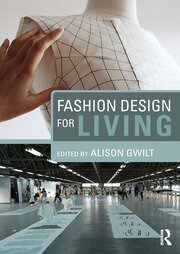Fashion Design for Living explores the positive contribution that the contemporary fashion designer can make within society. The book seeks to reveal new ways of designing and making fashion garments and products that not only enhance and enrich our lives, but also are mindful of social and sustainable issues.
This book sets out to question and challenge the dominant, conventional process of fashion design that as a practice has been under-researched. While the fashion designer in industry is primarily concerned with the creation of the new seasonal collection, designed, produced and measured by economically driven factors, society increasingly expects the designer to make a positive contribution to our social, environmental and cultural life. Consequently an emergent set of designers and research-based practitioners are beginning to explore new ways to think about fashion designing. The contributors within this book argue that fashion designing should move beyond developing garments that are just aesthetically pleasing or inexpensive, but also begin to consider and respond to the wearer's experiences, wellbeing, problems, desires and situations, and their engagement with and use of a garment.
Fashion Design for Living champions new approaches to fashion practice by uncovering a rich and diverse set of views and reflective experiences which explore the changing role of the fashion designer and inspire fresh, innovative and creative responses to fashion and the world we live in.
Acknowledgements Foreword Introduction Part 1: Fashion for Existence 1. Fashioning Publics: The Socially Responsive Design Practice of Vexed Generation 2. Fashion and Textiles Design for Wellbeing: Value Adding Through Practice-Led Transdisciplinary Design Research 3. Design for Ageing Well 4. Fashion and Sustainability: Repairing The Clothes We Wear 5. Fashion Design and Fashion Cooperatives: A Case Study of the Lydia Lavin Brand Part 2: Fashion for Engagement 6. Fashion People: Participating and Producing Fashion 7. Open Design and Digital Fabrication in Fashion 8. Form Empowered by Touch, Movement and Emotion 9. Fashion Design and Disability 10. Illuminative Smart Fashion. Index
Biography
Alison Gwilt is a fashion design academic, consultant and researcher exploring the integration of sustainable strategies across the lifecycle of fashion products. Her work focuses on the use of positive/sustainable design interventions within the fashion industry that challenge the current production and consumption paradigm. She has published widely in the field of sustainability and fashion, and her outputs include books, chapters, conference papers and articles published in the press and a number of international publications.Alison is Reader in Fashion and Sustainability at Sheffield Hallam University, UK
Her books include Shaping Sustainable Fashion (edited with Timo Rissanen) published by Earthscan in 2011, A Practical Guide to Sustainable Fashion for Bloomsbury (2014) and forthcoming, Fashion Design for Living for Routledge (2014). As a curator and practitioner, she has been involved in a number of exhibitions and received competitive funding from organizations such as the Australian NSW State Government’s Environmental Trust.
Alison has a degree in fashion and textiles from Central St Martins College of Art in London, and a PhD from RMIT University, Melbourne, and her career in academia includes managing courses, researching and lecturing in fashion and textiles design in the UK, New Zealand and Australia. She currently holds the post of Reader in Fashion and Sustainability in the Art and Design Research Centre at Sheffield Hallam University, UK.
'Fashion Design for Living provides wide-ranging case studies and diverse approaches to design for sustainability centred on the user experience of clothing and fashion, with a special focus on personal wellbeing, emotional engagement and collaborative design practice. The book is a valuable addition to resources for students and professionals on fashion and sustainability.' - Professor Sandy Black, Centre for Sustainable Fashion, University of the Arts London. Author/editor The Sustainable Fashion Handbook; Eco Chic: the Fashion Paradox
‘The call is clear. We need to think in new ways as we address current fashion challenges. By focusing on the well-being of people, through a user-centered design approach, innovative solutions will be found. This array of timely and inspiring essays is a solid start; read it and take action.’- Janet Hethorn, Director, Delaware Design Institute, University of Delaware, USA




